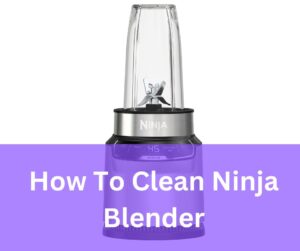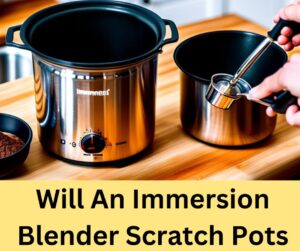Your blender’s performance and longevity may both be enhanced by having its blades sharpened. It’s a straightforward job that just needs a few tools and some labor. We’ll guide you through the process of sharpening your blender blades in this post so you can resume blending with ease. The procedure is largely the same whether you’re using a countertop blender or a portable immersion blender. You can quickly have your blender operating like new again with just a small amount of work.
How to Sharpen Blender Blades

- Make careful to disconnect your blender before you start disassembling it, then separate the blender jar from the base.
- To make a clean workspace, wash the blender, including the jar and blades.
- Using a wrench or pliers, remove the blades from the blender jar.
- Carefully remove the blades from the base after removing them from the jar.
- Use this chance to give the blades a thorough cleaning, getting rid of any dirt or food that has attached to them.
- The blades should then be sharpened using a sharpening stone. For this stage, you may alternatively use a file or fine-grained sandpaper. Just be careful to apply equal pressure to all areas of the blade with moderate, even strokes.
- Reassemble your blender once the blades have been sharpened to your satisfaction and test it to see whether the performance has improved. You’re good to go if everything is operating as it should! You can maintain your blender operating smoothly and effectively for years to come by following these easy tips.
How To Use Eggshells To Sharpen Blender Blades
Eggshells should not be used to sharpen blender blades. While some say that blending ground eggshells can help sharpen the blades, this approach is unlikely to be successful.
Eggshells are composed of calcium carbonate, a soft substance. They are unlikely to be abrasive enough to significantly alter the blades’ sharpness. Eggshells can also crack and become lodged in the blender’s blades, which can actually reduce its efficiency.
The use of a sharpening stone, fine-grit sandpaper, or a file is a more efficient way to sharpen blender blades. These tools are more suited to enhancing the performance of your blender because they were created expressly for sharpening.
It’s also crucial to remember that trying to sharpen your blender’s blades may violate the guarantee provided by the manufacturer. It is recommended to get advice from the manufacturer if your blender’s blades need to be sharpened while it is still covered under warranty.
How do you clean a blender?
What you’ll need to clean a blender with:
- Dish soap warm water
- a gentle fabric or sponge
Here is a detailed instruction:
- Remove the jar from the base of the blender and unplug it.
- To get rid of any loose dirt, give the jar and lid a warm water rinse.
- Warm water and a few drops of dish soap should be added to the jar.
- Put the jar’s lid on and pulse the appliance a few times to produce suds.
- The jar should be emptied and thoroughly washed with warm water.
- Use a gentle cloth or sponge to clean the base and control panel. Make sure to clean up any food splatters or residue.
- Use a sponge or towel that has been rinsed to scrub the blades clean. The blades are sharp, so take caution.
- Before putting the blender back together, thoroughly dry the jar, blades, and other components.
Should I get a blender or a food processor?
Both blenders and food processors are useful appliances to have in the kitchen, but they serve different purposes. Here is a summary of the main differences between the two:
Blenders:
- Mainly used for blending and pureeing soft to semi-soft ingredients
- Can also be used for grinding dry ingredients and making smoothies
- Typically have a jar with a blade assembly at the bottom
Food processors:
- Mainly used for chopping, shredding, and pureeing a variety of ingredients, including both soft and hard foods
- Can also be used for grinding dry ingredients and making dough
- Typically have a large bowl with a blade or shredding attachment that fits inside
Ultimately, the choice between a blender and a food processor will depend on your specific needs and the types of tasks you want to be able to perform in the kitchen. If you are mainly interested in blending and pureeing soft ingredients, a blender may be the better option for you. If you need a more versatile appliance that can handle a wider range of tasks, a food processor may be the better choice. It is also possible to find combination appliances that function as both a blender and a food processor, which can provide even more versatility in the kitchen.
Does ice sharpen blender blades? :
No, ice won’t make blender blades sharper. While some would assert that blending ice can assist hone a blender’s blades, this is untrue. In actuality, mixing ice over time can wear out the blades.
Blades in blenders are made to combine soft and semi-soft foods, not ice or other hard objects. The effort of blending ice exerts a lot of pressure on the blades, which can cause damage. The blades can eventually get dull as a result of this.
Does salt sharpen blender blades?
No, salt won’t make blender blades sharper. While some would assert that blending salt can assist hone a blender’s blades, this is untrue. In actuality, mixing salt over time can wear out the blades.
Do blender blades need to be replaced?
Although the precise lifespan may vary depending on the kind, quality, and frequency of usage of the blades, blender blades will eventually wear out and need to be replaced. Blender blades often endure for a number of years before needing to be changed.
Conclusion
In conclusion, honing your blender’s blades can help it function better and last longer. It’s a straightforward job that just needs a few tools and some labor. The procedure is largely the same whether you’re using a countertop blender or a portable immersion blender. Just be careful to unplug your blender, take it apart, and clean the blades before using a sharpening stone, fine-grit sandpaper, or a file to make them more razor-sharp. Apply light, and uniform pressure while sharpening the blade all the way around. Reassemble your blender and give it a test run once you’ve completed honing the blades to check whether the sharpening has improved performance. You can maintain your blender operating smoothly and effectively by following these tips.



